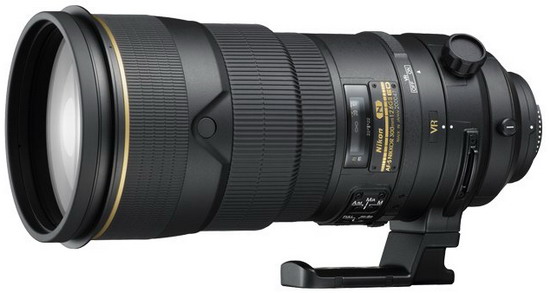Lens for $ 5900
In the world of photography, there remains a certain island of stability that is not subject to new-fashioned tendencies, simply because the laws of physics do not change. This island of stability is professional optics. It is not cheaper and does not decrease in size.

The new telephoto AF-S Nikkor 300mm f / 2.8G ED VR II by the very fact of its existence warms the soul of professional photographers. In short, we will explain why “crazy” people pay such money.
First of all, for speed. Thanks to the F2.8 aperture, it is possible to take clear pictures with an exposure of four times less than using a standard telephoto 200-250 mm for a couple of hundred dollars, because there is an F5.6 aperture. In other words, this professional monster with enlightened optics transmits an order of magnitude more light than ordinary lens lenses. Reducing exposure by four times - a very important quality, for example, for sports photography. Actually, without such a lens, a sports photographer can not go to work if he photographs not chess.
')
To provide such a luminosity for a large light-sensitive sensor, the lens must be made of a larger diameter. That is why professional televisions look so monstrous, like telescopes. Grinding large lenses to perfect shape and fitting the entire optical design of the lens is very expensive (by the way, telescopes are expensive for the same reason).
In addition to a slower shutter speed, such a lens provides better image quality for all other parameters: less distortion, better sharpness, contrast and color reproduction, less attenuation at the corners of the frame, etc.
Each manufacturer has its own proprietary technologies, in the development of which years and resources were invested. For example, Nikon has a Nano Crystal Coat nanocrystalline lens coating. For this, too, take the money.
Although optics itself in professional objectivities has practically not improved over the years and decades, progress is being made in the field of stabilization mechanisms. Now Canon and Nikon use a system of miniature gyroscopes in professional cameras to stabilize lenses while shooting hands. According to Nikon (professional photographers consider this figure too high), their stabilization system allows, without harm to the resulting image, to increase the exposure time by four feet, that is, for example, from 1/400 to 1/25 ( previous Nikon 300 mm F2 model ) 8 could only three feet).
via DeepTech

The new telephoto AF-S Nikkor 300mm f / 2.8G ED VR II by the very fact of its existence warms the soul of professional photographers. In short, we will explain why “crazy” people pay such money.
First of all, for speed. Thanks to the F2.8 aperture, it is possible to take clear pictures with an exposure of four times less than using a standard telephoto 200-250 mm for a couple of hundred dollars, because there is an F5.6 aperture. In other words, this professional monster with enlightened optics transmits an order of magnitude more light than ordinary lens lenses. Reducing exposure by four times - a very important quality, for example, for sports photography. Actually, without such a lens, a sports photographer can not go to work if he photographs not chess.
')
To provide such a luminosity for a large light-sensitive sensor, the lens must be made of a larger diameter. That is why professional televisions look so monstrous, like telescopes. Grinding large lenses to perfect shape and fitting the entire optical design of the lens is very expensive (by the way, telescopes are expensive for the same reason).
In addition to a slower shutter speed, such a lens provides better image quality for all other parameters: less distortion, better sharpness, contrast and color reproduction, less attenuation at the corners of the frame, etc.
Each manufacturer has its own proprietary technologies, in the development of which years and resources were invested. For example, Nikon has a Nano Crystal Coat nanocrystalline lens coating. For this, too, take the money.
Although optics itself in professional objectivities has practically not improved over the years and decades, progress is being made in the field of stabilization mechanisms. Now Canon and Nikon use a system of miniature gyroscopes in professional cameras to stabilize lenses while shooting hands. According to Nikon (professional photographers consider this figure too high), their stabilization system allows, without harm to the resulting image, to increase the exposure time by four feet, that is, for example, from 1/400 to 1/25 ( previous Nikon 300 mm F2 model ) 8 could only three feet).
via DeepTech
Source: https://habr.com/ru/post/78208/
All Articles